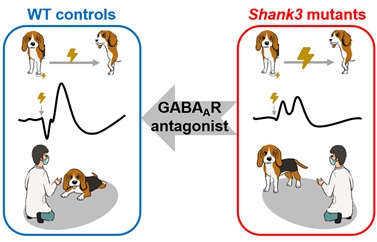Individuals with autism spectrum disorder (ASD) often exhibit diverse abnormalities in somatosensory processing, including hypo- or hyper-sensitivity to tactile stimuli. Early tactile dysfunction strongly correlates with later ASD symptoms including impaired social interactions. However, the neural basis of altered tactile reactivity in ASD patients is still unknown. Mutations in SHANK3, a gene encoding a synaptic scaffolding protein, have been repeatedly identified in ASD individuals. Dogs evolve alongside humans over a long history, and serve as an effective animal model for studying human psychiatric disorders. The somatosensory system including touch receptive fields and brain anatomies, and experimental paradigms in domestic dogs closely resemble that of humans.
In a recent study, led by Professor ZHANG Yong Q. from the Institute of Genetics and Developmental Biology, Chinese Academy of Sciences, in collaboration with Professor HU Li from the Institute of Psychology, Chinese Academy of Sciences, employed a Shank3 mutant dog model to investigate ASD-associated abnormalities in somatosensory processing.
Compared with wild-type (WT) dogs, Shank3 mutant dogs exhibited reduced not only tactile sensitivity, but also tactile-evoked cortical responses and tactile adaptation in the somatosensory cortex. In addition, Shank3 mutant dogs showed decreased spectral powers of resting-state brain oscillations at all frequencies. These findings shed new light on the potential neural mechanisms underlying somatosensory alterations of ASD.
Given the efficacy of the γ-aminobutyric acid A receptor (GABAAR) antagonist pentylenetetrazole (PTZ) in enhancing resting-state brain oscillations, they tried PTZ as a potential intervention to improve impaired brain oscillations as well as tactile responses. As expected, PTZ ameliorated the abnormalities in both tactile reactivity and brain oscillations, and also improved dog-human social interactions in Shank3 mutant dogs. The rescuing effect is crucial for understanding the potential relationship between tactile processing and social interaction behaviors.
Altogether, these findings underscore the pivotal role of Shank3 in somatosensory processing and suggest GABAAR antagonists as prospective therapeutic agents for a subset of ASD patients.
The study, entitled “Impaired Tactile Processing in Autism-Associated Shank3 Mutant Dogs: Neural Mechanism and Intervention” (DOI:10.1016/j.scib.2024.09.011), was published on 12 September 2024 in Science Bulletin.
This work is supported by the National Key Research and Development Program, the National Natural Science Foundation of China, the Beijing Natural Science Foundation, and the Spring City Plan.
Intervention of the Impaired Tactile Processing by GABAAR antagonists in Shank3 Mutant Dogs (Image by IGDB)
Contact:
Drs. ZHANG Yong Q. and HU Li
Institute of Genetics and Developmental Biology, Institute of Psychology, Chinese Academy of Sciences
 Intervention of the Impaired Tactile Processing by GABAAR antagonists in Shank3 Mutant Dogs (Image by IGDB)Contact:Drs. ZHANG Yong Q. and HU LiInstitute of Genetics and Developmental Biology, Institute of Psychology, Chinese Academy of SciencesEmails: yqzhang@genetics.ac.cn , huli@psych.ac.cn
Intervention of the Impaired Tactile Processing by GABAAR antagonists in Shank3 Mutant Dogs (Image by IGDB)Contact:Drs. ZHANG Yong Q. and HU LiInstitute of Genetics and Developmental Biology, Institute of Psychology, Chinese Academy of SciencesEmails: yqzhang@genetics.ac.cn , huli@psych.ac.cn CAS
CAS
 中文
中文




.png)
